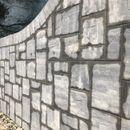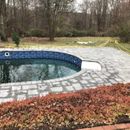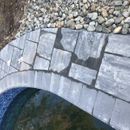Pavers Over Concrete Patio
Hi.
My first post here and unfortunately its not a good one.
I would like if anyone has some info on what is occurring.
I had a mason recently install Cement pavers over an existing concrete patio around my pool area, some of the area was grass and they laid gravel and sand to level it out so it would be even with the concrete (This area you can see no moisture is seeping through the pavers).
There is a ton of moisture seeping through where the joint sand is and my mason is adamant that the sand was incorrect.I gave him the benefit of the doubt and let him put new polymeric sand in.The moisture is still appearing but now it seems more evident than ever. This is now three weeks into the finished job and it just will not disappear. I have sen someone else posted this topic but wanted to see if anyone could please advise me on the issue.
I am in the east coast Connecticut and the weather the since the job was done has been at an average of mid 50’s.
Please see attachment.
I thank you for your time and any advice would be greatly appreciated.
GBA Detail Library
A collection of one thousand construction details organized by climate and house part












Replies
We need to find out more information here to narrow the causes down.
How old is the concrete the pavers sit on? Water does evaporate from curing concrete over time so we just want to make sure curing concrete is not the source here. I'm guessing it's not that new.
You mentioned polymeric sand was used to lock the pavers. Did the mason spray water over the surface to set the sand? Did he lift any of the pavers to check for moisture under the pavers when he re-did the sand? If he added more sand and again wet locked it there is now more moisture under the pavers. If he used a pressure washer to blow out the initial polymeric sand there is even more moisture under the pavers. Any rain you have had will not help this situation. Since it's only been in the 50's and much colder at night it may take a while to dry.
Was the concrete slab level to begin with? Pitched properly? If not moisture could be pooling underneath the pavers and then wicking up or evaporating through the joints
Is there a vapor barrier underneath the concrete patio?
Hi.
Thank you for your reply.
The concrete at a rough guess would be maybe 12-15 years old.
I don't think that they sprayed water over the pavers prior to laying down the polymeric sand, and no they never lifted any pavers to check for moisture. The mason did scrape out the original Polymeric sand I did see them do that and they leaf blew the old once it was released. We had a slight flurry of rain and snow yesterday.
Yes the Concrete slab was pitched correctly as when I was getting estimates for this job I also had a new liner put in the pool and had pool companies inspect the area.
I don't think there is a Vapor barrier under the patio but am not sure.
Hope these answers help.
Attached are two images of the concrete and the grass area are where the original red pavers that the masons graded off.
Thanks for giving more information. When polymeric sand is used water is sprayed after the sand is swept in to activate and harden the sand in the joints. I'm wondering if that water has migrated below the pavers. This time of year will take a longer time for things to dry out. You mentioned the mason said the polymeric sand was "incorrect". Did he describe this problem?
Good to hear the concrete is pitched correctly.
Are there screenings under the pavers or do they sit right on the concrete?
Hi There.
I met with the mason yesterday and posed some questions to him.
The pavers he said were laid on top of the concrete and they laid onto the cement ( no screeners as far as what I know).I asked if there should be some sand to absorb the moisture and I don't recall him laying the sand. He did say that due to the cold weather it may take time for the Polymeric sand to harden He is monitoring this issue and I am awaiting his response. I will update with any info I have.
The typical install when pavers are dry laid is over a .5" to 1" layer of sand or screenings on top of the slab or stone base. Drain holes are drilled through hard surface bases like your concrete slab at low points to help with drainage. Pavers can also be set in mortar over slabs but that is more common in commercial installations.
If moisture continues to be an issue you can ask the contractor why he dry laid the pavers directly over the concrete.
Thank you for your reply.I will be sure to ask the mason this.
Mason wants to test the Polymeric sand again for the third time.Not sure why he keeps wanting to do this.I asked him if there should be drainage holes set in the concrete slab and he doesn't think this will remedy the issue. Moisture starts to appear every morning around 10am when it starts to warm up a little and will remain visible all day.
Okay👍. Good luck. Both drainage holes in a slab and screenings or sand beneath pavers provide a way for moisture to escape constant contact with the pavers and paver joints.
Thanks appreciate your input.
How are you all???
Will you help me?
I have a SIMILAR ISSUE: theres a “V-shaped” Wetness.
I have 3 Photos here, that consistently show the V shape wetness under the pavers in winter, fall and even now, Spring 2021.
BIGGEST Problem is- my House is barely 8months old.
CURVE BALL is the fact that pavers are 20ft away from water/ large size pond that leads to a river-
Then to the Chesapeake.
Contractor said-
“It’s normal because of the high water table where my house is.”
IS THAT TRUE?
Is the wetness under the pavers NORMAL???????
Pls Help.
MissusFromM_aryland
Hi all I know this is an old thread but I am having the same issue with my new pool pavers. Has anyone had any resolution to this?
A concrete base on pavers is usually done with permeable concrete in my area so water drains through it. Otherwise I think a sufficient pitch to allow surface run off would be needed. I don't think more polymeric sand would do much if the water has no place to go.
It doesn’t have a concrete base. Just the typical base used by the mason. If I remember, it looked like sand. But even after a few days of sunshine wouldn’t the pavers dry out?
The sand or screenings under the pavers are meant to drain the water but there also should be slope for runoff. You would think the pavers should dry after a couple days. Sorry I can't be anymore helpful.
beanman- A specific area of your pavers or all of them? Do you notice this after any amount of rainfall no matter how much? Does it occur in a lower area? What's the base below the sand?